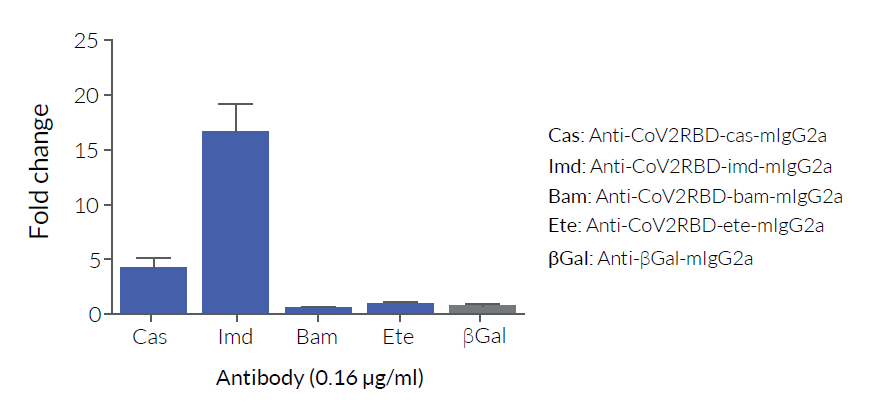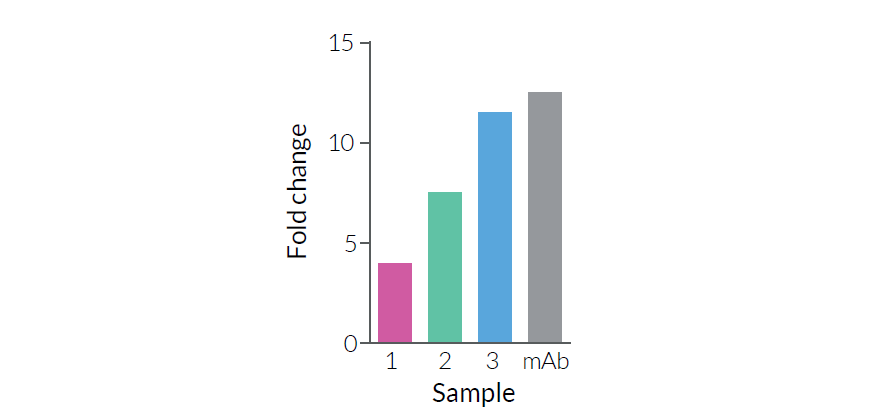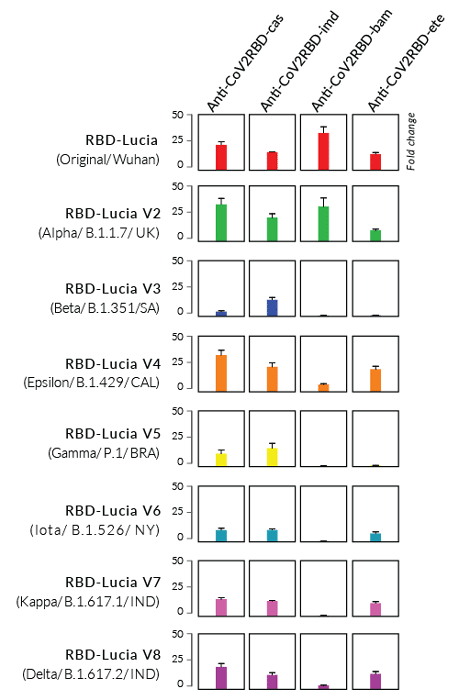Beta Variant - Luciferase-tagged RBD protein
| Product | Unit size | Cat. code | Docs. | Qty. | Price | |
|---|---|---|---|---|---|---|
|
RBD-LuciaV3 (B.1.351) Luciferase tagged RBD protein (B.1.351 variant) |
Show product |
50 µg |
rbd-lucia-v3
|
|
Recombinant RBD fusion protein (B.1.351 variant - South African origin) for ELISA & LIPS
RBD-LuciaV3 (B.1.351) (~52 kDa) is a soluble fusion protein composed of the Spike Receptor Binding Domain (RBD) from the SARS-CoV-2 Beta variant (B.1.351) fused to a C‑terminal Lucia luciferase tag. RBD-LuciaV3 (B.1.351) has been specifically designed to assess the binding affinity of anti-Spike antibodies using either ELISA or LIPS (luciferase immunoprecipitation systems) assays [1-3].
SARS-CoV-2 Spike RBD

Key mutations in the Beta variant (B.1.351) RBD
RBD-LuciaV3 (B.1.351) contains the Spike RBD domain, including the receptor-binding motif (RBM) from the SARS-CoV-2 Beta variant, first reported in South Africa in October 2020. [4-5]. This variant is classified as a member of Clade 20H/501Y.V2 and B.1.351 v2 lineage (Nextstrain/Pango lineage classification). It is characterized by the presence of a number of mutations within the Spike RBD coding region, which are of concern [4-5].
- K417N, E484K, N501Y
![]() Learn more about the emerging SARS-CoV-2 variants around the world
Learn more about the emerging SARS-CoV-2 variants around the world
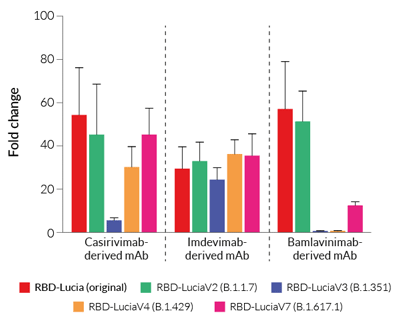
Binding affinity of Anti-Spike mAbs using
Spike variant RBD-Lucia proteins
Applications
Luciferase-tagged RBD proteins are ideal for studying the binding of anti-spike monoclonal antibodies (mAbs) by solid-phase ELISA and/or solution‑phase LIPS assays, as well as anti‑spike polyclonal antibodies in the sera of recovered COVID‑19 patients and/or vaccinees by LIPS [1-3].
- ELISA: the Lucia luciferase tag provides a larger dynamic range than the commonly used HRP detection.
- LIPS: for the detection of antibodies, against both linear and conformational epitopes.
Importantly, using InvivoGen's expanding collection of Spike variant RBD-Lucia proteins, it can be seen that the SARS-CoV-2 variants display varying binding affinities to the different clinically relevant anti-Spike mAbs (see right). RBD‑LuciaV3 (B.1.351) has been generated by recombinant DNA technology, produced in CHO cells, and purified by IMAC (Immobilized Metal Affinity Chromatography) using a C‑terminal histidine tag. Protein size and purity (>90%) have been validated by SDS‑PAGE and the absence of endotoxin contamination has been confirmed using cellular assays.
References:
 InvivoGen also offers:
InvivoGen also offers:
• REGN-10933 & REGN-10987-derived antibodies
• LY-CoV555 & LY-CoV016-derived antibodies
1. Burbelo, P.D. et al. 2010. Antibody-profiling technologies for studying humoral responses to infectious agents. Expert Rev Vaccines 9, 567-578.
2. Haljasmagi, L. et al. 2020. LIPS method for the detection of SARS-CoV-2 antibodies to spike and nucleocapsid proteins. Eur J Immunol 50, 1234-1236.
3. Liang, Y. et al. 2021. A luciferase immunosorbent assay for quantitative detection of IgG antibodies against SARS-CoV-2 nucleoprotein. J Virol Methods 292, 114141.
4. Garcia-Beltran, W.F. et al. 2021. Multiple SARS-CoV-2 variants escape neutralization by vaccine-induced humoral immunity. Cell. doi:10.1016/j.cell.2021.03.013
5. Tegally, H. et al. 2020. Emergence and rapid spread of a new severe acute respiratory syndrome-related coronavirus 2 (SARS-CoV-2) lineage with multiple spike mutations in South Africa. Medrxiv. doi:10.1101/2020.12.21.20248640v1
Specifications
RBD-LuciaV3 (B.1.351)
- Protein construction: RBD [R319-F541] from the Spike glycoprotein fused to a C-terminal Lucia luciferase reporter
- Origin: Beta Variant (B.1.351 lineage) | South African origin
- Sequence Reference: GISAID EPI_ISL_745146
- Tag: C-terminal 6x Histidine tag
- Total protein size: 461 amino acids (including the Lucia luciferase)
- Molecular weight: ~52 kDa (SDS-PAGE)
- Purification: Immobilized metal affinity chromatography (IMAC)
- Purity: >90% (SDS-PAGE)
-
Quality control:
- The protein has been validated by ELISA upon incubation with a coated Anti-murine IgG (Fab')2 and a clinically relevant anti-Spike mAb.
- The absence of bacterial contamination (e.g. lipoproteins and endotoxins) has been confirmed using HEK-Blue™ TLR2 and HEK-Blue™ TLR4 cellular assays.
Contents
RBD-LuciaV3 (B.1.351) contents:
- 50 μg of lyophilized protein
- 1.5 ml of endotoxin-free water
- 1 tube of QUANTI-Luc™ 4 Reagent, a Lucia luciferase detection reagent (sufficient to prepare 25 ml)
![]() The product is shipped at room temperature.
The product is shipped at room temperature.
![]() Lyophilized protein should be stored at -20°C.
Lyophilized protein should be stored at -20°C.
![]() Resuspended protein is stable for up to 1 month when stored at 4°C, and 1 year when stored at -20°C.
Resuspended protein is stable for up to 1 month when stored at 4°C, and 1 year when stored at -20°C.
Avoid repeated freeze-thaw cycles.
Back to the topDetails
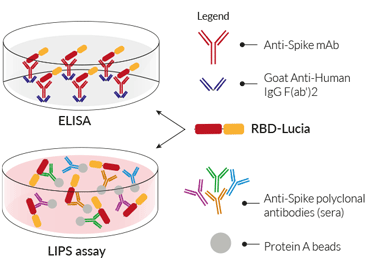
RBD-Lucia fusion protein for ELISA & LIPS
RBD-Lucia in ELISA
RBD-Lucia proteins can be used in a luciferase-based ELISA. Unlike a conventional ELISA, the plate is coated overnight with an Anti-human IgG F(ab')2 fragment. Upon addition of anti-spike monoclonal antibodies (mAb), they will bind to this 'capture' fragment through their Fc region, and RBD-Lucia will bind to the variable region. The luciferase activity is then used to assess the mAb binding affinity to the Spike RBD.
RBD-Lucia in LIPS
Currently, to perform a LIPS assay, soluble crude cell lysates or culture media of the luciferase tagged recombinant protein are extracted from transfected cells and directly used for the assay. InvivoGen's RBD-Lucia proteins streamline the protocol even further. Simply add the RBD-Lucia protein to either anti-spike mAbs or to anti‑spike polyclonal antibodies in the sera of recovered COVID‑19 patients and/or a vaccinee. Following this, antibody-protein complexes are purified using Protein A beads. Quantification of either binding affinity (mAb) and/or antibody levels (sera) is easily determined by assessing the Lucia luciferase activity.
Back to the top





